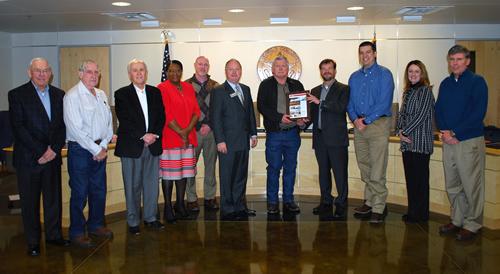
February 1, 2018 - The Health & Natural Sciences Building at Panola College has been recognized for design excellence in a national competition sponsored by American School & University magazine. David Zatopek of Corgan Architects, the Dallas architecture and design firm who designed and built the structure, presented the award to the Panola College Board of Trustees at the board meeting on Monday, January 29, 2018. Clint Binkley and Cody Stonger, both of Hunt Construction, were also present at the award presentation.
Announced in the Architectural Portfolio 2017 issue of American School & University magazine, the winning projects are also displayed online at SchoolDesigns.com. The Panola College project is featured in the online portfolio of 2017 winners that includes, among others, the American University of Central Asia in Kyrgyzstan, Washington University in St. Louis, Grand Rapids Community College in Michigan, the University of Hawaii Ka ‘lmi ‘lke Education Building, Edgecombe Community College in North Carolina, and the University of Texas Health Sciences Center at San Antonio Center for Oral Health Care.
The building’s design required careful planning to accommodate laboratories, classroom, study areas, and office space for the structure that anchors the southwest quadrant of the Carthage campus. Encompassing 64,000 square feet, the building was completed in August 2015.
In addition to the Health & Natural Sciences Building, Corgan designed and built the expansion to the M.P. Baker Library, and the Charles C. Matthews Foundation Student Center.
“It’s gratifying to learn that the Health & Natural Sciences Building has received this design award,” said Dr. Greg Powell, Panola College President. “Working with Corgan and Hunt Construction on this project was a pleasure. Our faculty, staff and students reap the benefits of their design expertise every day as we educate future health care professionals.”









